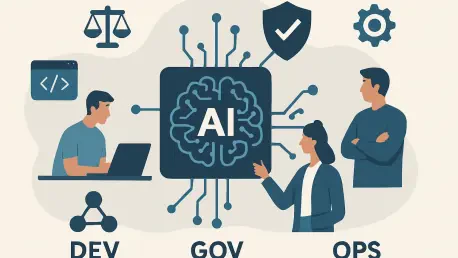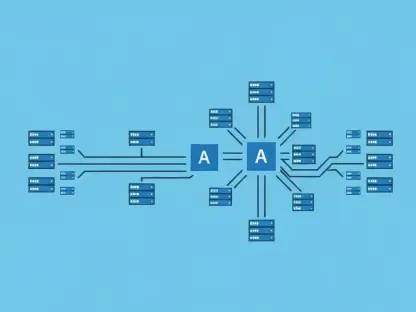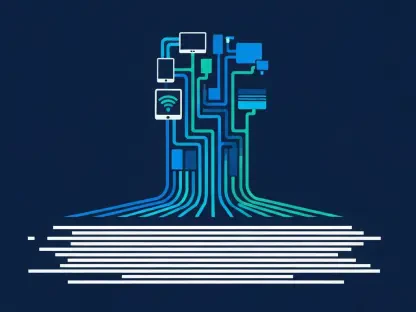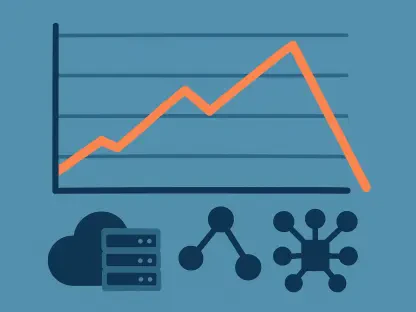In the fast-paced realm of software development, where innovation often outstrips oversight, a groundbreaking concept has surfaced to redefine the boundaries of DevOps. Unveiled at JFrog’s swampUp conference, DevGovOps introduces a pivotal shift by embedding governance directly into the heart of DevOps practices. As artificial intelligence (AI) becomes increasingly integral to software delivery, the demand for structured accountability and compliance has reached unprecedented levels. This emerging framework isn’t merely a trendy label; it’s a direct response to the complexities of modern enterprise technology, where unchecked experimentation can lead to significant risks. From navigating regulatory pressures to managing the unseen spread of AI tools, DevGovOps promises to balance the drive for innovation with the need for control. This exploration delves into the essence of this new paradigm, uncovering why it’s poised to become a cornerstone of responsible software development in today’s dynamic landscape.
Unpacking the Core of DevGovOps
DevGovOps emerges as a transformative approach by prioritizing governance within the DevOps ecosystem, an element often overlooked in favor of speed and agility. Unlike fleeting variations such as DevBizOps that failed to gain lasting traction, this concept mirrors the impactful integration seen with DevSecOps, which cemented security as a cultural and technical pillar. Governance here translates to establishing clear policies and mechanisms that ensure compliance with regulations, manage potential risks, and uphold accountability across teams. This becomes particularly critical in an era where AI-driven tools permeate development processes, often without formal oversight. By weaving these principles into the fabric of DevOps workflows, the framework aims to make governance an inherent part of the pipeline, rather than a cumbersome add-on that slows progress. The focus is on creating a system where rules support rather than hinder the rapid pace of software delivery, addressing a gap that has grown more evident with technological advancements.
The significance of DevGovOps lies in its ability to adapt to the current regulatory and technological environment, where stakes are higher than ever. Enterprise leaders face mounting pressure from boards and external bodies to demonstrate control over their digital operations, especially as data breaches and non-compliance penalties loom large. This framework offers a structured way to meet those demands without sacrificing the iterative, collaborative spirit that defines DevOps. It draws lessons from past iterations, recognizing that successful adaptations must address real, pressing needs rather than merely rebranding existing practices. With governance as a central tenet, DevGovOps seeks to provide clarity and direction in a landscape often muddled by rapid change, ensuring that organizations can scale their operations confidently. This approach signals a maturing of DevOps philosophy, one that acknowledges the necessity of oversight in sustaining long-term innovation and trust among stakeholders.
Confronting the Rise of Shadow AI
A primary catalyst for the rise of DevGovOps is the pervasive and often unregulated use of AI tools in software development, commonly termed “shadow AI.” Developers and teams across enterprises are adopting powerful platforms like ChatGPT and GitHub Copilot to boost productivity, frequently bypassing formal IT channels or approval processes. While this experimentation fuels creativity, it also opens the door to significant vulnerabilities, including security gaps and compliance violations that can jeopardize entire organizations. Without proper oversight, the use of such tools can lead to unintended exposure of sensitive data or integration of unverified code into critical systems. DevGovOps steps in to address these concerns by embedding mechanisms for visibility and control directly into development pipelines, ensuring that AI adoption doesn’t become a liability. The goal is to create an environment where innovation is encouraged, but within boundaries that protect both the organization and its stakeholders.
Beyond the immediate risks, the broader implications of shadow AI are driving a cultural shift in how technology is managed at the enterprise level. Executive boards and regulatory bodies are increasingly demanding transparency into how AI tools are utilized, spurred by high-profile incidents of misuse and the potential for hefty fines. This pressure trickles down to development teams, who must now balance their drive for efficiency with accountability to stricter guidelines. DevGovOps offers a pragmatic solution by integrating automated checks and balances that monitor AI usage and flag potential issues before they escalate. This proactive stance helps mitigate the chaos of unregulated experimentation, providing a framework where teams can leverage cutting-edge tools while adhering to organizational standards. As AI continues to reshape software delivery, this balance becomes not just beneficial but essential for maintaining trust and operational integrity across complex, distributed environments.
Real-World Solutions Through DevGovOps
Practical implementations of DevGovOps are already taking shape, as demonstrated by JFrog’s initiatives unveiled at the swampUp conference, where platform enhancements underscored the framework’s relevance. These updates target critical areas such as AI supply chain management, ensuring that the origins of AI models are verified, and artifact trust, which guarantees the integrity of software components. Additionally, tools for licensing compliance help organizations navigate the legal complexities of using AI-generated code, preventing costly oversights. Much like DevSecOps revolutionized how security was prioritized in development cycles, DevGovOps positions governance as an equally indispensable element, aligning software delivery with both internal policies and external regulations. These real-world applications highlight how the framework can tackle tangible challenges, offering a blueprint for enterprises aiming to integrate AI responsibly without derailing their development timelines.
The impact of these solutions extends beyond mere compliance, fostering a more resilient approach to software development in an AI-driven era. By embedding governance directly into DevOps pipelines, organizations can address risks at the source—whether it’s unverified code slipping into production or unlicensed components triggering legal issues. JFrog’s focus on automation within these tools ensures that governance doesn’t become a manual burden but rather a seamless part of the process, allowing teams to maintain their pace of delivery. This practical emphasis sets DevGovOps apart from theoretical concepts, grounding it in actionable strategies that enterprises can adopt today. As more companies grapple with the dual demands of innovation and accountability, such implementations serve as proof that governance can enhance rather than obstruct the development lifecycle, paving the way for broader industry adoption of this evolving framework.
Striking a Balance Between Freedom and Control
One of the most pressing challenges with DevGovOps is ensuring that governance doesn’t morph into bureaucratic overreach, which could stifle the very innovation it aims to protect. The allure of AI lies in its capacity to drive experimentation and rapid problem-solving, qualities that have transformed how software is built and deployed. If governance mechanisms are too rigid or punitive, they risk dampening this creative spirit, turning a potential enabler into a barrier. The ideal vision for DevGovOps is one where oversight acts as a supportive framework—think automated systems that log AI tool usage, verify adherence to policies, and alert teams to potential risks in real time. This approach allows developers to push boundaries with confidence, knowing that protective guardrails are in place to prevent catastrophic missteps, thereby preserving the dynamic nature of modern software development while addressing critical accountability needs.
Achieving this balance requires a nuanced understanding of both technology and organizational dynamics, ensuring that DevGovOps evolves as a collaborative tool rather than a top-down mandate. Automation plays a pivotal role here, reducing the friction that often accompanies manual oversight and enabling governance to scale alongside development efforts. By focusing on transparency—such as clear documentation of AI interactions and compliance status—teams can maintain agility without sacrificing responsibility. This equilibrium is vital as enterprises navigate increasingly complex regulatory landscapes and internal expectations. DevGovOps, when implemented thoughtfully, transforms governance from a perceived obstacle into a catalyst for sustainable progress, empowering developers to innovate within a structure that safeguards organizational interests. The challenge lies in continuous refinement, ensuring that these systems adapt to emerging technologies without losing sight of their core purpose.
Navigating the Future of Responsible Tech
The ascent of DevGovOps mirrors a broader industry movement toward intertwining technology with accountability, a trend accelerated by AI’s pervasive influence across software lifecycles. Traditional oversight mechanisms have struggled to keep pace with the speed at which AI is integrated by developers, testers, and analysts alike, often leaving gaps in control. Industry insights, such as those from Gartner, point to rising budgets for CIOs under pressure to manage these technologies responsibly, reflecting a shift in priorities at the highest levels. DevGovOps responds by positioning governance as a proactive, inseparable component of DevOps practices, ensuring that enterprises can harness AI’s potential while mitigating its risks. This alignment with current needs underscores why the framework is gaining traction as a necessary evolution, addressing the intersection of innovation and responsibility in a way that older models cannot.
Looking ahead, the implications of this shift are profound, as DevGovOps sets a precedent for how technology and governance can coexist without conflict. By embedding accountability into everyday workflows through automation and transparency, enterprises can build a culture of trust that extends from development teams to executive boards. This framework not only addresses immediate concerns like shadow AI but also prepares organizations for future challenges, such as evolving regulations or new technological disruptions. As the industry continues to grapple with balancing speed and safety, DevGovOps offers a path forward that prioritizes both, ensuring that software delivery remains a driver of progress rather than a source of risk. The journey to fully realizing this vision will require ongoing collaboration and adaptation, but the foundation laid by DevGovOps marks a critical step toward a more responsible and sustainable tech landscape.









